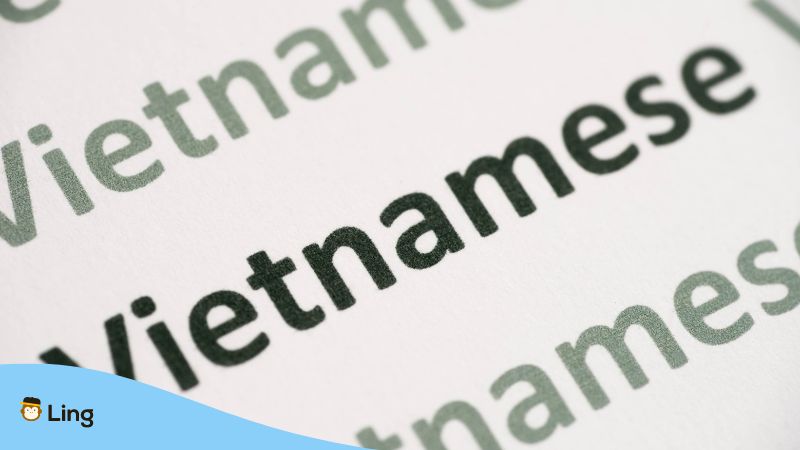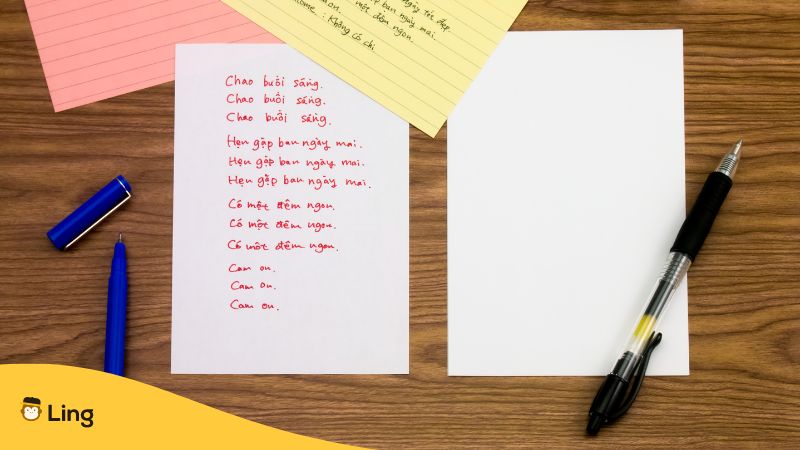Are you baffled by Vietnamese grammar? Don’t worry—you’re not alone. Learning any language can feel like navigating a labyrinth; Vietnamese is no exception. I still remember my first attempt at learning Vietnamese — the daunting diacritics, the tricky tenses, and don’t get me started on pronunciations! It seemed like an impossible task.
But here’s the truth: mastering grammar opens the magical portals to understanding the Vietnamese language effectively and fluently. In this post, we’ll explore the basics of Vietnamese grammar, from nouns to sentence structures.
Before you know it, you’ll be chatting away confidently as if you’ve been speaking Vietnamese your whole life! So sit back, relax, and get ready for the ultimate grammar adventure that’ll take your Vietnamese skills to new heights. Let’s dive in!
Vietnamese Sentence Structure
When you learn Vietnamese, you’ll notice that it’s quite different from many European languages. Being an analytic language, the grammar heavily relies on word order and sentence structure rather than using word changes (inflections) to convey meaning.
The Basic Vietnamese Grammar Rule: SVO (Subject-Verb-Object)
Put away those flashcards for grammatical structures. Vietnamese grammar isn’t as complicated as you might think. At the core of it, Vietnamese sentences follow a Subject-Verb-Object (SVO) pattern. If you’re already familiar with English or other SVO languages, this will be a walk in the park!
For example, let’s take a look at the sentence Cô ấy ăn bánh mì (She eats bread):
- Cô ấy (She) – Subject
- Ăn (eats) – Verb
- Bánh mì (bread) – Object
Just arrange the Vietnamese words in the SVO order, and you’re golden!
Jazzing It Up With Modifiers
Now that we’ve got that basic snap in our step, let’s amp things up with a bit of jazz: the modifiers! Here’s the catch – adjectives and adverbs in Vietnamese follow the word they describe.
Let’s plug this into our earlier example:
- She eats tasty bread (Cô ấy ăn bánh mì ngon)
Also, when using quantity words (like “some” or “a lot”), put them before the noun:
- She eats some bread (Cô ấy ăn một ít bánh mì)
Prepositions: Fitting In the Puzzle Pieces
Step right up for our brief pit stop at Vietnamese prepositions! Here’s the winning formula: they typically go before the noun they link up with.
Here are a few examples:
- I arrive at the house of my friend. (Tôi đến ở nhà của bạn)
- We go into the classroom. (Chúng tôi đi vào phòng học)
See, it’s all starting to come together! Now there’s just one more thing…
Negative Sentences: Easy-Peasy
Making a sentence negative in Vietnamese is as simple as adding “không” before the verb. It’s like saying not or don’t in English.
For example:
- I don’t eat pizza. (Tôi không ăn pizza)
And there we have it! You’ve just conquered the vital basics of Vietnamese sentence structure. In the next section, we’ll cover all the little details that will help you make sense of everything.

Vietnamese Nouns
Now, let’s delve deeper into the wonderful Vietnamese language. We’re about to tackle an essential piece of the puzzle, Vietnamese nouns. This is a lot easier than it sounds, I promise!
Nouns in Vietnamese are refreshingly straightforward. Let’s break down the essentials you need to know about them:
No Genders: Unlike some languages you might have encountered, good news – Vietnamese nouns don’t have genders! That’s right; there’s no need to worry about masculine or feminine forms.
No Plurals: Another fascinating aspect of Vietnamese nouns is the lack of plural forms. We use the same noun to express both singular and plural, and the context will usually make the meaning clear.
Noun Classifiers
One of the key features of Vietnamese nouns is the use of “classifiers.” These little words might sound fancy, but they’re just a simple way to categorize nouns based on their shapes, sizes, or other attributes. Let’s take a look at some common classifiers:
| Vietnamese Classifier | Use | Examples |
| Cái | Inanimate objects | Chairs, tables |
| Con | Animals | Dog, cat |
| Bài | Articles | Songs, drawings, poems, essays |
| Cây | Stick-like objects | Umbrellas, sticks, canes |
| Quyển/Cuốn | Book-like objects | Book, magazine |
Here’s an example to help you understand how to use classifiers:
- English: Two dogs
- Vietnamese: Hai con chó (Hai = two, con = classifier, chó = dogs)
Don’t worry if this seems overwhelming right now. The more you practice, the more natural it will feel!
Vietnamese Verbs
In any language, verbs are essentially the heartbeat. They bring life to our sentences, making them ‘move’ with actions and states. In Vietnamese, they’re equally vital. Plus, the good news is – they are simpler than you might think!
No Conjugation, Seriously?
Yes, you heard it right! One of the great parts about Vietnamese verbs is that conjugations simply don’t exist. Ah, the relief of not having to memorize a zillion verb changes like in some other languages, right? So, whether you’re saying “I work,” “You work,” or “They work,” the verb remains the same – “làm việc.” Easy-peasy!
Time Markers: Tenses Made Simple
So how exactly do we tell the difference between the past, present, and future without conjugations? When it comes to tense, Vietnamese doesn’t rely on changing the verb itself. Instead, it uses small particles. Here are the basics:
- Past tense: Add the particle “đã” before the verb.
- Present progressive tense: Use the particle “đang” before the verb.
- Future tense: Put the particle “sẽ” before the verb.
But remember, in some cases using these particles isn’t absolutely necessary. The context will often help you figure out the tense.

Vietnamese Adjectives
In Vietnamese, adjectives are like mood setters, painting vivid images with words. The fun part is they’re extremely adaptable. Whether you’re describing a tall person “người cao,” a short story “câu chuyện ngắn,” or a difficult task “nhiệm vụ khó,” an adjective in Vietnamese is always up to the task. Straightforward, isn’t it?
The first fascinating fact about Vietnamese adjectives is that they don’t need the verb “to be” – trust me, it took me by surprise, too. That means if you want to express something like “She’s beautiful” in Vietnamese, you can just say, “She beautiful!” Interesting, right?
So, let’s illustrate this with an example following Vietnamese syntax SVO:
The phrase “You are very beautiful” translates into “Em rất đẹp” in Vietnamese. You’ll notice that the “are” is missing in the translation. We directly use the adverb “rất” (very) followed by the adjective “đẹp” (beautiful). It’s as if you’re saying, “You very beautiful.” Kinda quirky, huh?
Position Of Adjectives In Vietnamese
Now let’s talk about where to put these adjectives in your sentences. Unlike in English, where adjectives typically go before the noun they describe, Vietnamese adjectives come after the noun phrase. So, “the green apple” becomes “quả táo xanh,” which is “apple green” when directly translated back to English. A little switcheroo!
Vietnamese Adverbs
If adjectives are the spice, adverbs are the tempo switches. They subtly change the ‘speed’ and ‘intensity’ of verbs, showing us how, when, or to what extent something is done. The good news? Adverbs are mostly formed from adjectives. Add “một cách” before an adjective, and voilà! You have an adverb! “Một cách nhanh chóng” means “quickly” – now, isn’t that a handy trick?
Last but not least, remember our friend ‘không’? This nifty little word transforms any adjective or adverb into its negative form. If something’s not quick, just say “không nhanh”. If a story’s not short, it’s “không ngắn”. And like that, you can slide through negations with ease.
Vietnamese Conjunctions
In Vietnamese, conjunctions come in all shapes and sizes. They include words like “and,” “but,” “so,” “because,” and so forth. They’re those little keywords that create connections and build relationships between parts of a sentence.
Here are a few important Vietnamese conjunctions that are super handy to have in your language toolkit:
| English | Vietnamese | Example | Translation |
| And | Và | I like tea and coffee. | Tôi thích trà và cà phê. |
| But | Nhưng | I like tea, but I do not like coffee. | Tôi thích trà, nhưng tôi không thích cà phê. |
| So | Nên | He is tired, so he goes to sleep. | Anh ấy mệt, nên anh ấy đi ngủ. |
| Because | Bởi vì | I am late because I stayed up late. | Tôi đi trễ bởi vì tôi thức khuya |
Having these fundamental connection words in your language repertoire will make sentences click into place!

Unleash Your Language Superpowers
Congratulations! You’ve reached the end of our language journey, where we’ve explored the fascinating world of Vietnamese grammar together. From its distinctive word order to its intricate verb forms, you now hold the key to unlocking the true essence of this beautiful language.
Remember, language learning is all about embracing the adventure and enjoying the process. So, take a deep breath and reflect on what you’ve achieved. By mastering Vietnamese grammar, you’ve opened doors to new friendships, expanded your cultural horizons, and gained a deeper appreciation for the Vietnamese way of life.
Sure, the path to mastery may have twists and turns, but don’t let that discourage you. Learning a language is a lifelong journey. So, celebrate those “a-ha” moments, those milestones that remind you of how far you’ve come.

Learn Vietnamese With Ling
Are you ready to embark on an exciting language-learning adventure? Look no further than the Ling App! With its user-friendly interface and engaging content, Ling App is the ultimate companion for language enthusiasts of all levels. Whether you’re a beginner eager to grasp the basics or an advanced learner seeking to refine your skills, Ling App has got you covered.
Ling App has various fun challenges, quizzes, and rewards that will keep you coming back for more. Track your progress, earn points, and unlock exciting achievements along the way, making your language learning journey all the more enjoyable.
Oh, and did we mention the convenience of the Ling App? Accessible on your mobile device, you can learn on the go, wherever and whenever it suits you. Commute to work, take a study break, or relax in your favorite coffee shop while immersing yourself in the world of languages. The possibilities are endless!



































































